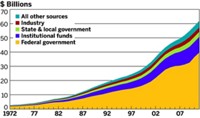Advertisement
Grab your lab coat. Let's get started
Welcome!
Welcome!
Create an account below to get 6 C&EN articles per month, receive newsletters and more - all free.
It seems this is your first time logging in online. Please enter the following information to continue.
As an ACS member you automatically get access to this site. All we need is few more details to create your reading experience.
Not you? Sign in with a different account.
Not you? Sign in with a different account.
ERROR 1
ERROR 1
ERROR 2
ERROR 2
ERROR 2
ERROR 2
ERROR 2
Password and Confirm password must match.
If you have an ACS member number, please enter it here so we can link this account to your membership. (optional)
ERROR 2
ACS values your privacy. By submitting your information, you are gaining access to C&EN and subscribing to our weekly newsletter. We use the information you provide to make your reading experience better, and we will never sell your data to third party members.
Business
2010 Academic R&D Spending Trends
Outlays up 10.6% for chemistry, above the 6.3% growth for science and engineering as a whole
by Carmen Drahl
October 22, 2012
| A version of this story appeared in
Volume 90, Issue 43

To view all tables as PDFs, visit http://cenm.ag/10rd.
In 2010, the most recent fiscal year for which data are available from the National Science Foundation, funds from the American Recovery & Reinvestment Act of 2009, known as the economic stimulus package, made their long-awaited appearance. Those new funds explain why spending figures are far better than might be expected, given the current economic malaise.
Academic R&D spending for science and engineering fields totaled $58.3 billion in 2010. That figure increased 6.3% from 2009. This is an improvement over 2009’s growth of 5.8% as well as 2008’s growth of 4.8%. But it still lags behind the early 2000s, when annual spending growth approached or hit double digits.
Taking into account the effect of inflation, R&D spending went up 5.4% in terms of constant dollars between 2009 and 2010. For the decade ending in 2010, spending increased 54.7% in constant dollars (93.9% in current dollars) over the previous decade.
Academe receives most of its monies from the federal government. The federal sector’s 2010 contribution—$36.5 billion, a 12.1% increase over the prior year—amounted to 62.6% of the total. That boost is far above the 7.6% annual average increase between 2000 and 2010. However, some other sources decreased outlays. Institutions kicked in $10.6 billion, down from $11.1 billion in 2009, and state and local governments contributed $3.6 billion, only slightly down from $3.7 billion.
The 2010 fiscal year saw little change to the relative share of expenditures within the various sectors of science and engineering. Science accounted for 84.0% of science and engineering R&D spending in 2010, a 6.0% increase over 2009 to $49.0 billion. The biggest portion of that went to the life sciences, as usual, which saw a 6.5% increase to $34.9 billion, or 59.8% of the total 2010 science, technology, engineering, and mathematics (STEM) R&D budget.
The physical sciences had more to celebrate in 2010 compared with the life sciences. Chemistry, physics, astronomy, and other physical sciences expenditures saw a jump of 8.0% overall to $4.6 billion in 2010, for a 7.9% share of the total. As opposed to last year, when physics saw most of the growth, 2010 was chemistry’s turn, with a spending increase of 10.6% to $1.8 billion. Chemistry’s piece of the science budget pie hit 3.0% in 2010 after several years at 2.9%.
On a constant-dollar basis, chemistry saw a 9.6% spending hike between 2009 and 2010. Between 2000 and 2010, chemistry R&D spending rose 45.2% in constant dollars (82.0% in current dollars).
Spending in engineering increased 8.0% to $9.3 billion in current dollars, or 16.0% of the total STEM R&D expenditures. Although the sector overall posted a smaller increase than last year, chemical and materials engineers enjoyed big boosts. Chemical engineering spending increased 14.5% to $797 million, holding steady at 1.4% of the total. Materials engineers saw a whopping 32.0% boost to $908 million, 1.6% of the STEM total.
Federal investment in engineering R&D has for several years grown more than investment in basic science. But in 2010 the gap was not quite as large as in previous years. Support for science R&D from the government grew 11.7% in 2010, reaching $30.8 billion, and engineering saw growth of 13.8% to $5.7 billion. Chemistry’s $1.2 million outlay topped 2009’s by 15.8%, above the 6.6% average throughout the prior decade.
California Institute of Technology once again spent the most money for chemistry R&D from all sources combined. Caltech has been top dog for five of the past six years. It took only a 3.0% spending increase to $35.6 million to retain its rank. Rutgers, the State University of New Jersey, stayed in second place with an 8.2% boost to $34.2 million. Despite a 0.3% decline in spending to $30.1 million, the University of Illinois, Urbana-Champaign (UIUC), moved up to third. Massachusetts Institute of Technology and Harvard University completed the top five.
Harvard and the University of North Carolina, Chapel Hill, in ninth place, were the biggest upward movers among the top 10 chemical R&D spenders. In 2009, Harvard placed 12th and UNC Chapel Hill placed 16th.
The top chemical engineering R&D spender in 2010, Georgia Institute of Technology, also kept its place from 2009. Its expenditure increased 12.3% to $28.2 million, a more modest increase from its 27.3% rise for 2009. Rounding out the top five were Ohio State University, MIT, the University of South Carolina, and the University of Texas, Austin.
The federal government’s biggest outlay for chemical R&D in 2010 went to Rutgers. The university’s $29.1 million share was a 13.3% boost from 2009, about on par with its average annual change for the past decade. Caltech stayed at number two with a more modest 3.7% increase to $27.0 million. However, MIT fell to number three with an 11.6% decline in federal dollars. Other schools in the top five were UNC Chapel Hill and UIUC.
The largest federal allotment for chemical engineering R&D in 2010 went again to Johns Hopkins University, which notched a 15.0% increase to $16.2 million. Oklahoma State University rocketed to number four from number 118 after a large boost in federal chemical engineering funding to its new University Multispectral Laboratories, which are designed to speed commercialization of technologies for defense and energy, according to Alan Tree, associate dean of research. Georgia Tech, MIT, and the University of Delaware rounded out the top five.
Combined outlays for chemical research equipment hit $162.0 million in 2010, a 19.2% increase over 2009. Ranking highest was MIT with a $4.4 million outlay, followed by the University of Michigan; Arizona State University, Tempe; the University of Wisconsin, Madison; and Cornell University.
In 2010, federal support for chemical research equipment was up in a big way—37.9% to $112.9 million. Schools with the most support were Arizona State, Tempe; MIT; UNC Chapel Hill; the University of Kansas; and UW Madison.
Once again, numbers of students seeking graduate degrees in chemistry edged upward in 2010, this time by 1.5% to 22,436. The population of chemical engineering grad students was up 5.9% to 8,668. As is typical, about half of the chemical engineering students and more than one-third of the chemists were from outside the U.S. The number of life sciences graduate students slipped for the second year in a row in 2010.
The number of postdoctoral-level chemists barely budged in 2010, increasing 0.5% to 4,241. Ranks of chemical engineering postdocs also held steady, with a 0.7% boost to 1,092.
Data for this article were drawn primarily from NSF’s WebCASPAR database of academic science and engineering statistics, which can be accessed online at webcaspar.nsf.gov. Further information came from NSF’s Higher Education Research & Development (HERD) Survey, which can be viewed at nsf.gov/statistics/nsf12330. For the 2010 fiscal year, which NSF classifies as the period July 1, 2009, through June 30, 2010, the agency rolled out the newly redesigned HERD Survey. The Survey of Research & Development Expenditures at Universities & Colleges collected information for 1972–2009. The HERD Survey includes fields other than science and engineering, whereas the earlier survey does not.
To view all tables as PDFs, visit http://cenm.ag/10rd.




















Join the conversation
Contact the reporter
Submit a Letter to the Editor for publication
Engage with us on Twitter